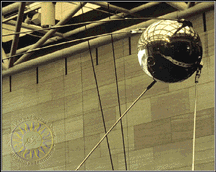This is an artist's conception of the Earth and its radiation belts.
Click on image for full size
The Discovery of the Radiation Belts
The belts of trapped radiation above the Earth's atmosphere, but within the magnetosphere, were first detected by James Van Allen in 1958. Therefore these belts are also known as Van Allen Belts.
When Sputnik I, the first spacecraft, was launched in 1957 by the Soviet Union, the Americans were anxious to respond. The Americans wanted to not only launch a satellite, but to learn something new!
Dr. James Van Allen had already been exploring the upper atmosphere of the Earth with balloons that could obtain information about radiation levels in the atmosphere. Van Allen and his team placed a Geiger counter and an altimeter on Explorer I, the first American spacecraft, to take radiation readings at different altitudes.
During the flight, radiation levels seemed to increase and then suddenly drop to zero and then again to increase, then suddenly drop to zero. What the team soon realized was that regions appearing as zero were really off the scale! These high-radiation regions were mapped and are now known as the Van Allen radiation belts.
Scientists recalibrated the Geiger counter for later flights, and Explorer III confirmed the existence of the Van Allen radiation belts.
You might also be interested in:

The Earth's radiation belts are one component of the larger and more complex system called the magnetosphere. The radiation belts of the Earth are made up of energetic, electrically charged particles or
...more
The Soviet Sputnik program consisted of four satellites, three of which reached Earth orbit. Sputnik 1, launched on Oct.4, 1957, became the first artificial satellite to successfully orbit the Earth. It
...more
The Earth has a magnetic field with north and south poles. The magnetic field of the Earth is enclosed in a region surrounding the Earth called the magnetosphere. As the Earth rotates, its hot core generates
...more
The belts of trapped radiation above the Earth's atmosphere, but within the magnetosphere, were first detected by James Van Allen in 1958. Therefore these belts are also known as Van Allen Belts. When
...more
Earth has a magnetic field. If you imagine a gigantic bar magnet inside of Earth, you'll have a pretty good idea what Earth's magnetic field is shaped like. Of course, Earth DOESN'T have a giant bar magnet
...more
Earth has a global magnetic field that is approximately, though not exactly, a dipole field (like a bar magnet) with a north pole and a south pole. Earth's North Magnetic Pole (NMP) is not in the same
...more
Altocumulus clouds (weather symbol - Ac), are made primarily of liquid water and have a thickness of 1 km. They are part of the Middle Cloud group (2000-7000m up). They are grayish-white with one part
...more














